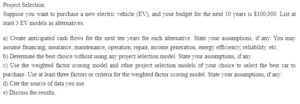Project Selection
Anticipated Cash Flows
| Alternatives | Mini-Van | Moped | Civic | BMW |
| Initial cost | $25,000 | $15,000 | $20,000 | $53,000 |
| Operating and maintenance cost | $1,000 | $750 | $700 | $1,500 |
| Life | 10 years | 10 years | 10 years | 10 years |
Assumptions made:
- The car should have a five-star safety rating, airbags, and be in good condition
- The electric vehicle should cost $25,000 or less
- It should incorporate sporty and cool factors in style.
- Its ongoing costs (maintenance, gas, insurance) should be less than $625 because the budget should not go beyond $100,000 for ten years (625*10*12+25,000= $100,000)
The Best Choice
When no project selection model is considered, Moped would be the best alternative because of the lowest prices across the four alternatives. The assumption in this selection is that the lowest-priced vehicle is the best.
Need a copy of the “Project Selection” ? Get in touch with us.
Weighted Factor Scoring Model of Selection
Five stages are considered when using the weighted factor scoring model. The selection criteria and factors applied in the method are determined in the first stage. This model uses four factors: style, safety, ongoing costs, and price (Adhikari et al., 2020). In the second stage, weights are assigned to each factor. The style factor is accorded 30%, 5% for the safety factor, 40% for the ongoing costs factor, and 25% for the price factor. In the third stage, a scale is selected based on the factors, whereby two points are awarded for meeting the criteria, one point for closer to satisfaction, and zero for failing to meet the requirements. The assignment of the points is as given below:
| Mini-Van | Moped | Civic | BMW | ||
| Style | 30% | 0 | 1 | 1 | 2 |
| Safety | 5% | 2 | 0 | 1 | 0 |
| Ongoing costs | 40% | 1 | 2 | 2 | 0 |
| Price | 25% | 1 | 2 | 2 | 0 |
The scores are multiplied by weights in the next stage to determine the best selection. The multiplication is as given below:
| Mini-Van | Moped | Civic | BMW | ||
| Style | 30% | *0=0 | *1=30 | *1=30 | *2=60 |
| Safety | 5% | *2=10 | *0=0 | *1=5 | *0=0 |
| Ongoing costs | 40% | *1=40 | *2=80 | *2=80 | *0=0 |
| Price | 25% | *1=25 | *2=50 | *2=50 | *0=0 |
| Total | 75 | 160 | 165 | 60 |
Civic is selected as the best alternative based on the weighted actor model; it has the highest score of 165. The score is high concerning favorable ongoing costs, price, safety, and style.
References
Adhikari, M., Ghimire, L. P., Kim, Y., Aryal, P., & Khadka, S. B. (2020). Identification and analysis of barriers against electric vehicle use. Sustainability, 12(12), 4850.
ORDER A PLAGIARISM-FREE PAPER HERE
We’ll write everything from scratch
Question 
Project Selection
Suppose you want to purchase a new electric vehicle (EV), and your budget for the next 10 years is $100,000. List at least 3 EV models as alternatives.

Project Selection
a) Create anticipated cash flows for the next ten years for each alternative. State your assumptions, if any. You may assume financing, insurance, maintenance, operation, repair, income generation, energy efficiency, reliability, etc.
b) Determine the best choice without using any project selection model. State your assumptions, if any.
c) Use the weighted factor scoring model and other project selection models of your choice to select the best car to purchase. Use at least three factors or criteria for the weighted factor scoring model. State your assumptions, if any.
d) Cite the source of data you use.
e) Discuss the results.